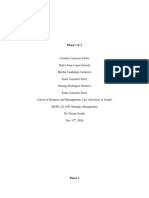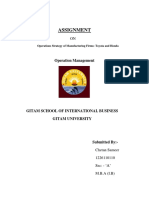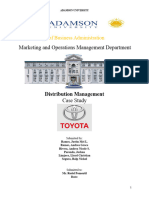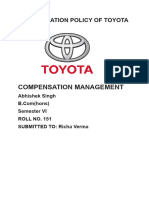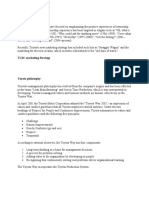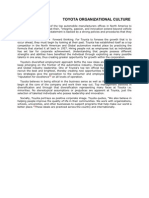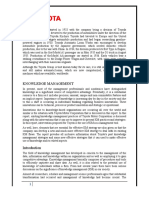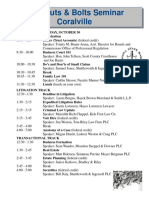Toyota Motor Corporation: Darwin D. Ambalong (BS AIS)
Toyota Motor Corporation: Darwin D. Ambalong (BS AIS)
Uploaded by
Karma AkabaneCopyright:
Available Formats
Toyota Motor Corporation: Darwin D. Ambalong (BS AIS)
Toyota Motor Corporation: Darwin D. Ambalong (BS AIS)
Uploaded by
Karma AkabaneOriginal Title
Copyright
Available Formats
Share this document
Did you find this document useful?
Is this content inappropriate?
Copyright:
Available Formats
Toyota Motor Corporation: Darwin D. Ambalong (BS AIS)
Toyota Motor Corporation: Darwin D. Ambalong (BS AIS)
Uploaded by
Karma AkabaneCopyright:
Available Formats
Toyota Motor Corporation
Toyota Motor Corporation engages in the manufacture and sale of motor vehicles
and parts. It operates through the following segments: Automotive Operations, Financial
Services, and All Other. The Automotive Operations segment designs, manufactures,
assembles and sells passenger cars, minivans, trucks, and related vehicle parts and
accessories. It is also involved in the development of intelligent transport systems. The
Financial Services segment offers purchase or lease financing to Toyota vehicle dealers and
customers. It also provides retail leasing through lease contracts purchase by dealers. The All
Other segment deals with the design and manufacture and sale of housing,
telecommunications and other businesses. The company was founded by Kiichiro Toyoda on
August 28, 1937 and is headquartered in Toyota, Japan.
Planning Process in Toyota
1. Setting goals
Toyota has identified specific company objectives is to achieve simultaneously high
quality, low cost, short lead times, and flexibility. Having a clear objective in mind makes
people less doubtful to their actions since there is a goal they can refer to.
Darwin D. Ambalong (BS AIS)
Toyota Motor Corporation
2. Develop commitment
Then, the leaders try to motivate their employees because goals don’t encourage them
to worker harder or smarter. Thus, they were armed with their shop-floor knowledge,
dedicated engineers, managers, and workers who would give their all to help the company
succeed. Things like praises and rewards do so much more than one actually realizes.
3. Develop effective action plan
They move to next step of planning is to develop effective action plans to their
objectives. Toyota lists the specific steps (how), people (who), resources (what) and time
period (when) for accomplishing a goal. A plan is systematic and should be followed
thoroughly, one does not go in a bath tub without filling it with water first.
4. Track progress toward goal achievement
After completing second step, they use the method of tracking progress toward goal
achievement to get more motivating and rewarding and then gather and provide performance
feedback to make adjustment in efforts, direction and strategy that will lead to dramatic
increase in performance. A simple reminder that one's effort are bearing actual results makes
a difference both in motivation and outputs given.
5. Maintain flexibility
Finally is maintaining flexibility, which is the key to their operations. They learned
from experiences and failures and improve them to satisfy their customers and get the best
productions. Everyone trips and falls but only fools stay on the ground,not even bothering to
look above.
They accept challenges with a creative spirit and the courage to realize their own
dreams without losing drive or energy. They approach their work vigorously, with optimism
and a sincere belief in the value of our contribution. Furthermore, they strive to decide their
own fate. They act with self-reliance, trusting in their own abilities. They accept
responsibility for their conduct and for maintaining and improving the skills that enable them
to produce added value. Toyota understands that in a typical business system, meeting and
exceeding the customer’s requirements is the task of everyone within an organization. And
they comprehended the definition of customer to include both internal and external
customers. Each person or step in a production line or business process was to be treated as a
customer and to be supplied with exactly what was needed, at the exact time needed.
Darwin D. Ambalong (BS AIS)
Toyota Motor Corporation
Toyota’s Organizational Structure
Toyota Motor Corporation’s organizational structure is based on the varied business
operations of the company around the world. As one of the world’s leading automobile
manufacturers, Toyota employs its organizational structure to support business goals and
strategic direction. This structure is also linked to the traditional organizational structures
used in Japanese businesses. The effectiveness of Toyota in maintaining a strong global
presence shows its ability to use its organizational structure to maximize efficiency and
capacity utilization. In essence, this organizational structure is a contributor to Toyota’s
success in the global market.
Toyota Motor Corporation’s organizational structure defines the patterns or
arrangements in the firm’s resources and processes. This corporate structure facilitates the
company’s effective and efficient business management.
Features of Toyota’s Organizational Structure
Toyota has a divisional organizational structure. This structure underwent significant
changes in 2013. This was seen as a response to the safety issues and corresponding product
recalls that started in 2009. In the old organizational structure, Toyota had a strong
centralized global hierarchy that was more like a spoke-and-wheel structure. The company’s
headquarters in Japan made all the major decisions. Individual business units did not
communicate with each other, and all communications had to go through the headquarters.
However, this organizational structure was widely criticized for slow response times to
address safety issues. After the reorganization that was implemented in 2013, Toyota’s new
organizational structure now has the following main characteristics:
Global Hierarchy. Toyota still maintains its global hierarchy despite its reorganization in
2013. However, in the current organizational structure, the company has increased the
decision-making power of regional heads and business unit heads. In essence, Toyota’s
decision-making processes became less centralized. Nonetheless, all business unit heads
report to the firm’s global headquarters in Japan.
Geographic Divisions. Toyota’s new organizational structure has eight regional divisions
(Japan, North America, Europe, East Asia and Oceania, China, Asia and Middle East, Africa,
and Latin America and Caribbean). Each regional head reports to the company’s
headquarters. Through these regional divisions, the organizational structure enables Toyota to
improve products and services according to regional market conditions.
Product-based Divisions. Another feature of Toyota’s organizational structure is the set of
product-based divisions. The company has four of these divisions: (a) Lexus International, (b)
Toyota No. 1 for operations in North America, Europe and Japan, (c) Toyota No. 2 for
operations in all other regions, and (d) Unit Center, which is responsible for engine,
transmission and other related operations. This feature of Toyota’s organizational structure
supports development of brands and product lines.
Implications of Toyota’s Organizational Structure
Toyota’s new organizational structure provides a greater degree of flexibility
compared to the old centralized hierarchical organizational structure. With this new structure,
the company is now more capable of responding to regional market conditions. This
Darwin D. Ambalong (BS AIS)
Toyota Motor Corporation
flexibility empowers Toyota to speedily respond to issues and to provide higher quality
products. However, the increased decision-making power of regional heads has reduced
headquarters’ control over the global organization. Still, this organizational structure
facilitates business resilience and continued growth.
Leading in Toyota
There are several external and internal factors to consider as Toyota’s management
use leading. Focus on the four functions are: globalization, technology, innovation, and
diversity.
In the Toyota production system and the Toyota way, let us know it is to provide
employees a tool, so that they can continue to improve the working system, Toyota model
just leaned more on employees, rather than reduce dependence on staff. Toyota way is a kind
of culture, rather than just a set of improved efficiency and improvement tools and methods,
you must rely on employees to reduce inventory, find out the hidden problem, and solve the
problem, employees have a sense of urgency, purpose, and the concept of teamwork, because
if they can’t solve the problem, inventory shortage situation occurs. During the daily
operations, engineers, suppliers and supervisors, and workers, are all involved in problem
solving and continuous improvement work, over time, everyone was trained to be more
effective to solve the problem. Facilitate and strengthen the team cooperation spirit, must rely
on the necessary help, training and reward. To encourage employees to properly maintain and
continuous improvement process and the workplace environment.
In Toyota, executives often encourage and help their employees. In any staff when in
trouble, both the boss and colleagues, they will go to provide the corresponding help to get
the job done. Because they think the team spirit is important. This not only allowed them to
finish the work smoothly, also make them in leading to high personal accomplishment. And
Darwin D. Ambalong (BS AIS)
Toyota Motor Corporation
technology allows management to be leaders and to motivate their employees by sending
congratulations e-mails to the top sales employee or by telling them what they have earned if
they sell a specific amount of vehicles. Motivating employees helps keep the morale strong,
and the Internet helps communicate motivational messages across different countries and
departments.
The important points of leading not only inspiring employees, but also
communication with customer. In Toyota, they figured out to develop a new customer is
equal to six old customers. To keep an old customer, by loyalty. Loyalty will be made for our
customers bring more publicity, this is the most effective free advertising. A large number of
cases and the fact that the wealth of the enterprise’s bring for loyalty customer. With a old
customers have a good communication is very important. However how to develop new
customer? The manager organizes information using technology such as the Internet, which
the customers can search more information regarding their vehicles and their prices. They
also organize information for the employees so they can see new information which is out,
such as the recall on the Toyota vehicles. Then they can tell their customers what to expect
and how to handle the situation.
In Toyota Company, managers give information to employees and customers. At the
same time they will get employees and customer feedback from various aspects. This way
make the managers understand the difficulty of employees and the company is what aspects
need to improve and progress. The conversation with customer to understand customer needs,
how to do let customer satisfaction products. You can also change many of the after-sales
service is the need to increase.
Toyota Quality Control
I. Know Your Suppliers
II. The Compliance Oversight Committee
III. Don’t Let Growth Overwhelm You
IV. Lessons for the Compliance Practitioner
MOTIVATION PRACTICES IN TOYOTA
Basically, Maslow’s Hierarchy of needs is pyramid of different levels of needs. The
base at the lowest is Physiological needs, the next is Safety needs, Love & Belonging, then
Esteem and the highest level is Self-Actualization (Please refer to Figure 1 for more details).
Only when lower levels of needs such as physiological and safety are satisfied, then
employees can achieve higher levels such as esteem and self-actualization, which make them
work more efficiently, with more drive and more innovative ideas.
Darwin D. Ambalong (BS AIS)
Toyota Motor Corporation
FIGURE 1 – MASLOW’S HIERARCHY OF NEEDS.
Retrieved from http://www.bzzzworks.com/images/infographics/maslow_pyramid.png
For Physiological & Safety needs:
According to Liker (2004, p.210), all employees of Toyota are satisfied in lower level
needs, they are well paid, their jobs are secured and the working environment is safe and
organized. Besser (1995, p.390) also stated that Toyota provided child care and recreational
facilities available on site for employees. All these benefits were provided to ensure their
employees are safe and secured to work for a higher level of needs, which brings more
results.
For the Needs of Belonging:
Darwin D. Ambalong (BS AIS)
Toyota Motor Corporation
Besser (1995, p. 390) described the way Toyota promoted a strong team spirit and
sense of belonging is by showing no discrimination between team members; or between
managers and employees. In particular, “There are no private parking facilities, private
cafeterias for managers, private offices, or private secretaries. All staff are encouraged to
wear the company uniform and are called by their first name” (Besser, 1995, p.390). This
practice makes employees really feel that they are a part of a community and creates a strong
bond between employees and the company.
For Esteem & Self-Actualization:
Toyota also encourages its employees to try to solve challenging problems to build up
their confidence so that they can satisfy their higher needs in esteem and self-actualization.
Also, by using a ratio of team leader to team members of 1 to 4, or 5; comparing to 1 to 20 or
30 in the industry, Toyota created 4 to 5 times the promotion opportunities for employees
(Besser, 1995, p. 393). Ambitious workers are also promised that their assembly line jobs are
temporary and after being promoted to team leader, they would receive a lot of training and
job rotation opportunities.
All employees are also encouraged to solve daily work problems innovatively, they
would receive gift certificates for their ideas contribution.
References:
Besser, T. (1995, May). Rewards and Organizational Goal Achievement: A Case Study of
Toyota Motor Manufacturing in Kentucky. Journal of Management Studies, 383-399.
Bodek, N. (2008). Toyota managers know the road to Lean is by way of
motivation. Retrieved at http://web.ebscohost.com
Liker, J. K. (2004). The Toyota Way: 14 Management Principles from the World’s Greatest
Manufacturer. Madision, Wisconsin, USA: McGraw-Hill.
Liker, J. K. (2004). The Toyota Way: 14 Management Principles from the World’s Greatest
Manufacturer. Madision, Wisconsin, USA: McGraw-Hill.
Liker, J. K., & Meier, D. P. (2007). Toyota Talent – Developing Your People The Toyota
Way. Chicago, United States of America: McGraw-Hill. doi: 10.1036/0071477454
http://panmore.com/toyota-organizational-structure-analysis
Toyota Motor Corporation (2012). June 15, 2012: Last Organizational Chart.
Toyota Motor Corporation (2013). TMC Announces New Organizational Structure and
Executive Changes.
http://fcpacompliancereport.com/2011/07/toyota-quality-control-and-a-best-practices-
compliance-program/
Darwin D. Ambalong (BS AIS)
You might also like
- Case Study On OrganisationDocument6 pagesCase Study On Organisationbuviaro100% (3)
- Toyota Kata: Managing People for Improvement, Adaptiveness and Superior ResultsFrom EverandToyota Kata: Managing People for Improvement, Adaptiveness and Superior ResultsRating: 4 out of 5 stars4/5 (10)
- Toyota Company Analysis Project ReportDocument21 pagesToyota Company Analysis Project Reportatulkumar2201No ratings yet
- Toyota Organizational StructureDocument4 pagesToyota Organizational StructureSarthak ChincholikarNo ratings yet
- Strategic Business AnalysisDocument4 pagesStrategic Business AnalysisRogen Paul Geromo100% (1)
- Strategy Implementation of ToyotaDocument11 pagesStrategy Implementation of Toyotataha shakirNo ratings yet
- Santa Ana PampangaDocument7 pagesSanta Ana PampangaKarma AkabaneNo ratings yet
- GB-T 706-2008Document29 pagesGB-T 706-2008Daniel SherwinNo ratings yet
- Animal Feeds Production ProposalDocument4 pagesAnimal Feeds Production Proposalwriter top100% (4)
- PurpleTeam BUS495 Draft2Document29 pagesPurpleTeam BUS495 Draft2Katty GonzalezNo ratings yet
- Running Head:: Organizational Design & DevelopmentDocument12 pagesRunning Head:: Organizational Design & DevelopmentMurathi MwangiNo ratings yet
- Toyota Motor CorporationDocument9 pagesToyota Motor CorporationFiza ZahidNo ratings yet
- TOYOTADocument5 pagesTOYOTAspergeonNo ratings yet
- HRD in Toyota Motor Corporation: Submitted To: Proff. Radhamohan ChabeluDocument9 pagesHRD in Toyota Motor Corporation: Submitted To: Proff. Radhamohan ChabeluDhananjay SinghNo ratings yet
- Assignment On Toyota Strategy SPIDocument12 pagesAssignment On Toyota Strategy SPImjaiqbal100% (1)
- Significant Organizational Change at Toyota Motor CompanyDocument10 pagesSignificant Organizational Change at Toyota Motor CompanySơn BadGuyNo ratings yet
- Buella, Queen April S. - Weekly Activity 1Document2 pagesBuella, Queen April S. - Weekly Activity 1Buella, Ladylyn S.No ratings yet
- Change Factors and Drives Analysis:: Discussion Task: 1Document17 pagesChange Factors and Drives Analysis:: Discussion Task: 1Arsalan ChaudhryNo ratings yet
- ToyotaDocument12 pagesToyotaHmed VedNo ratings yet
- Toyota’s Approach to Developing and Coaching Leaders: Toyota Production System ConceptsFrom EverandToyota’s Approach to Developing and Coaching Leaders: Toyota Production System ConceptsRating: 5 out of 5 stars5/5 (1)
- Case StudyDocument7 pagesCase Studyapi-288135534No ratings yet
- Performance Management and Reward Sysytem Project Report ON "Toyota's Compensation and Incentive Structure"Document14 pagesPerformance Management and Reward Sysytem Project Report ON "Toyota's Compensation and Incentive Structure"ANUMULA BHAVANANo ratings yet
- Toyota Motor ManufacturingDocument5 pagesToyota Motor ManufacturingDron ChapranaNo ratings yet
- Toyota Motor Corporation Business Strategy ImplementationDocument3 pagesToyota Motor Corporation Business Strategy ImplementationAmar narayanNo ratings yet
- Case Study AnswerDocument1 pageCase Study AnswerAbdul Rehman100% (1)
- Section 1 Answer To Question 1 Financial IssuesDocument9 pagesSection 1 Answer To Question 1 Financial IssuesmazharfrqNo ratings yet
- Toyota DissertationDocument5 pagesToyota DissertationWhereCanIFindSomeoneToWriteMyCollegePaperCanada100% (1)
- ToyotaDocument29 pagesToyotaMohamed Ahmed AbdelatyNo ratings yet
- Nokia HR ChallengeDocument6 pagesNokia HR ChallengeAshish Nikam100% (1)
- Change ManagementDocument17 pagesChange ManagementUmair Khalidi100% (2)
- Ito PoDocument6 pagesIto PoJohary EsmailNo ratings yet
- Assignment: Operation ManagementDocument19 pagesAssignment: Operation ManagementSwagat LenkaNo ratings yet
- Case Study Group1 (Toyota)Document22 pagesCase Study Group1 (Toyota)Andrea RamosNo ratings yet
- Research Report On Toyota Motors: Saad Khan Ma'am Mehreen AshrafDocument16 pagesResearch Report On Toyota Motors: Saad Khan Ma'am Mehreen AshrafKhawar ZamanNo ratings yet
- Toyota Motor CompanyDocument2 pagesToyota Motor CompanyMhellody Agustin PenamoraNo ratings yet
- Toyota Way To No !Document6 pagesToyota Way To No !Luka KurdgeliaNo ratings yet
- Capital IntensityDocument4 pagesCapital IntensityAfaq GhaniNo ratings yet
- Andon Refers To A System To Notify Management, Maintenance, and Other Workers of A Quality or Process ProblemDocument2 pagesAndon Refers To A System To Notify Management, Maintenance, and Other Workers of A Quality or Process ProblemCheryl GanitNo ratings yet
- TQM Implementation in ToyotaDocument15 pagesTQM Implementation in ToyotaSaikat GhoshNo ratings yet
- Unit 2Document29 pagesUnit 2Achyut TimalsinaNo ratings yet
- PT. Astra Honda Motor Strategy EnglishDocument7 pagesPT. Astra Honda Motor Strategy EnglishliaNo ratings yet
- Analysis of Toyota Motor CorporationDocument7 pagesAnalysis of Toyota Motor CorporationMohamed Ibrahim Siraj0% (2)
- Group Ii QMS - OriginalDocument22 pagesGroup Ii QMS - OriginalFayeedris Nahyan BarillaNo ratings yet
- TOYOTADocument12 pagesTOYOTAAbhishek SinghNo ratings yet
- Managing Growth - Group 2Document35 pagesManaging Growth - Group 2Ishan JawraniNo ratings yet
- Toyota HRMDocument14 pagesToyota HRMAbhinav PrasadNo ratings yet
- Toyota CompanyDocument8 pagesToyota CompanyEisha MahamNo ratings yet
- Operations Improvement Plan Implementation Assignment 1 - Week 5Document6 pagesOperations Improvement Plan Implementation Assignment 1 - Week 5dbryant1435100% (1)
- Toyota FinalDocument33 pagesToyota FinalDeo KumarNo ratings yet
- HRD in ToyotaDocument3 pagesHRD in ToyotaLai Thanh SonNo ratings yet
- MarketingDocument3 pagesMarketingluckyboy_2244No ratings yet
- The Functions of Management and How They Are Implemented in Toyota CorporationDocument5 pagesThe Functions of Management and How They Are Implemented in Toyota CorporationKimmy Ethan YusofNo ratings yet
- Case Analysis of Toyotas HRDocument14 pagesCase Analysis of Toyotas HRThu Hương LêNo ratings yet
- HR Practices For Sustainable Corporate Growth - The Toyota WayDocument19 pagesHR Practices For Sustainable Corporate Growth - The Toyota WaySaravana KadirvelNo ratings yet
- Toyota Organizational CultureDocument3 pagesToyota Organizational CultureAkhil Bansal89% (9)
- HRM in ToyotaDocument5 pagesHRM in ToyotaLai Thanh SonNo ratings yet
- Preliminary AssessmentDocument9 pagesPreliminary AssessmentZerihunNo ratings yet
- Knowledge Management Knowledge Management: Emerging TrendsDocument16 pagesKnowledge Management Knowledge Management: Emerging Trendsceo kareertraxNo ratings yet
- Assigment TQM Version 4 ParapharasedDocument10 pagesAssigment TQM Version 4 ParapharasedSHINDE ANIKET MARUTI / UPMNo ratings yet
- Group Report KM - IncompleteDocument6 pagesGroup Report KM - IncompleteSyed Bilal AliNo ratings yet
- 2223-2-MGT-Synoptic-Team 5Document3 pages2223-2-MGT-Synoptic-Team 5Andry Eloise JacaNo ratings yet
- Group3 GOD ToyotaDocument11 pagesGroup3 GOD ToyotariddhikunduNo ratings yet
- Toyoto & HondaDocument20 pagesToyoto & HondaChetan SameerNo ratings yet
- Globalization of ReligionDocument11 pagesGlobalization of ReligionKarma AkabaneNo ratings yet
- Nilagang BaboyDocument1 pageNilagang BaboyKarma AkabaneNo ratings yet
- Week 16-17 Module in Research PaperDocument5 pagesWeek 16-17 Module in Research PaperKarma AkabaneNo ratings yet
- Gives A Similar Effect From A Desired Good or Service Satisfy The Same Need From A Good or Service Replace Sagood OR ServiceDocument2 pagesGives A Similar Effect From A Desired Good or Service Satisfy The Same Need From A Good or Service Replace Sagood OR ServiceKarma AkabaneNo ratings yet
- Global Divides: The North and The SouthDocument9 pagesGlobal Divides: The North and The SouthKarma AkabaneNo ratings yet
- Lesson 4: The Self in Western and Eastern Thoughts: Tips and Tools For Creating and Presenting Wide Format SlidesDocument18 pagesLesson 4: The Self in Western and Eastern Thoughts: Tips and Tools For Creating and Presenting Wide Format SlidesKarma Akabane92% (13)
- Economics: Unlimited Wants ScarcityDocument27 pagesEconomics: Unlimited Wants ScarcityKarma AkabaneNo ratings yet
- The Causes and Effects of EarthquakesDocument4 pagesThe Causes and Effects of EarthquakesKarma AkabaneNo ratings yet
- Economic SystemsDocument6 pagesEconomic SystemsKarma AkabaneNo ratings yet
- Lesson 5 - Family PlanningDocument86 pagesLesson 5 - Family PlanningKarma AkabaneNo ratings yet
- Introduction To Quality: DHVTSU-Sto. Tomas CampusDocument53 pagesIntroduction To Quality: DHVTSU-Sto. Tomas CampusKarma AkabaneNo ratings yet
- Causes and Effects of EarthquakesDocument4 pagesCauses and Effects of EarthquakesKarma AkabaneNo ratings yet
- Readings in Philippine History Quiz 3 - 4 - Midterm EXAMDocument18 pagesReadings in Philippine History Quiz 3 - 4 - Midterm EXAMKarma Akabane100% (3)
- Chapter 1 Defining GlobalizationupdatedDocument51 pagesChapter 1 Defining GlobalizationupdatedKarma Akabane92% (24)
- Reality of LiesDocument2 pagesReality of LiesKarma Akabane100% (1)
- Group 4 - Case 3Document1 pageGroup 4 - Case 3Aishwarya OgreyNo ratings yet
- Chapter 07Document22 pagesChapter 07marieieiemNo ratings yet
- Solution Inventory Management in Class Activity 1Document5 pagesSolution Inventory Management in Class Activity 1Raviteja GogineniNo ratings yet
- Whats Really Going On in CourtDocument632 pagesWhats Really Going On in CourtCarla DiCapriNo ratings yet
- MIS Strategic Plan For Tesla MotorsDocument11 pagesMIS Strategic Plan For Tesla MotorsRintu Adhikary33% (3)
- Ammeraal Beltech: Innovation & Service in BeltingDocument6 pagesAmmeraal Beltech: Innovation & Service in BeltingDzakiyya TalitaNo ratings yet
- Business Analyst-DDocument1 pageBusiness Analyst-DSamad Raza KhanNo ratings yet
- CH 3 Characteristics of Hospitality and Tourism OrganizationsDocument14 pagesCH 3 Characteristics of Hospitality and Tourism Organizationsjuri100% (2)
- Presentation of Manpower Reduction Plan For Management Meeting April 23, 2020Document24 pagesPresentation of Manpower Reduction Plan For Management Meeting April 23, 2020tatosumartoNo ratings yet
- PFZ (Tide-Dec18-0626)Document3 pagesPFZ (Tide-Dec18-0626)ShimaKenthizNo ratings yet
- Payroll Accounting - 2024Document19 pagesPayroll Accounting - 2024angelbotshelo80No ratings yet
- International Marketing MbaDocument9 pagesInternational Marketing MbaHemant Kumar AhirwarNo ratings yet
- 31 DECAMBER FromDocument8 pages31 DECAMBER FromMd Rajikul IslamNo ratings yet
- Job Transfer Request FormDocument1 pageJob Transfer Request FormAmitabh VarmaNo ratings yet
- Chap002 Consolidation of Wholly Owned Subsidiaries With No DifferentialDocument73 pagesChap002 Consolidation of Wholly Owned Subsidiaries With No DifferentialMd. Rejaul Ahsan ChowdhuryNo ratings yet
- CC Unit 4, Cover Letters of Offers - To STDocument12 pagesCC Unit 4, Cover Letters of Offers - To STchan wolfNo ratings yet
- Case Study 26 Finalized 1Document11 pagesCase Study 26 Finalized 1auni fildzah100% (1)
- Introduction To Introduction To Cleaner Production (Cleaner Production (CP CP) ) Concepts Concepts and Practice and PracticeDocument65 pagesIntroduction To Introduction To Cleaner Production (Cleaner Production (CP CP) ) Concepts Concepts and Practice and PracticeprinceNo ratings yet
- Hindustan Unilever RevisedDocument7 pagesHindustan Unilever Revisedsujal JainNo ratings yet
- Resume - Madison FergusonDocument2 pagesResume - Madison Fergusonapi-556502508No ratings yet
- CMA LabourDocument81 pagesCMA LabourAvYlashKumbharNo ratings yet
- Auditing Problems 1-1Document1 pageAuditing Problems 1-1Jorz Pantaleta50% (8)
- TD - 71 - Personality Development WebinarDocument3 pagesTD - 71 - Personality Development Webinarryan abanicoNo ratings yet
- 2010 G.R. No. 178697 2010 11 17Document12 pages2010 G.R. No. 178697 2010 11 17Henry LNo ratings yet
- अवकाश कोषको आयकर निर्देशकDocument15 pagesअवकाश कोषको आयकर निर्देशकShiva Ram ShresthaNo ratings yet
- Day 5 - Alif Ruzy K - Bonus Malus SchemeDocument13 pagesDay 5 - Alif Ruzy K - Bonus Malus SchemefoxdadangNo ratings yet
- Introduction To Management AccountingDocument22 pagesIntroduction To Management AccountingmydiuNo ratings yet
- Is The Audit Services Market Competitive Following Arthur Andersen's Collapse?Document26 pagesIs The Audit Services Market Competitive Following Arthur Andersen's Collapse?ionus_2003No ratings yet









